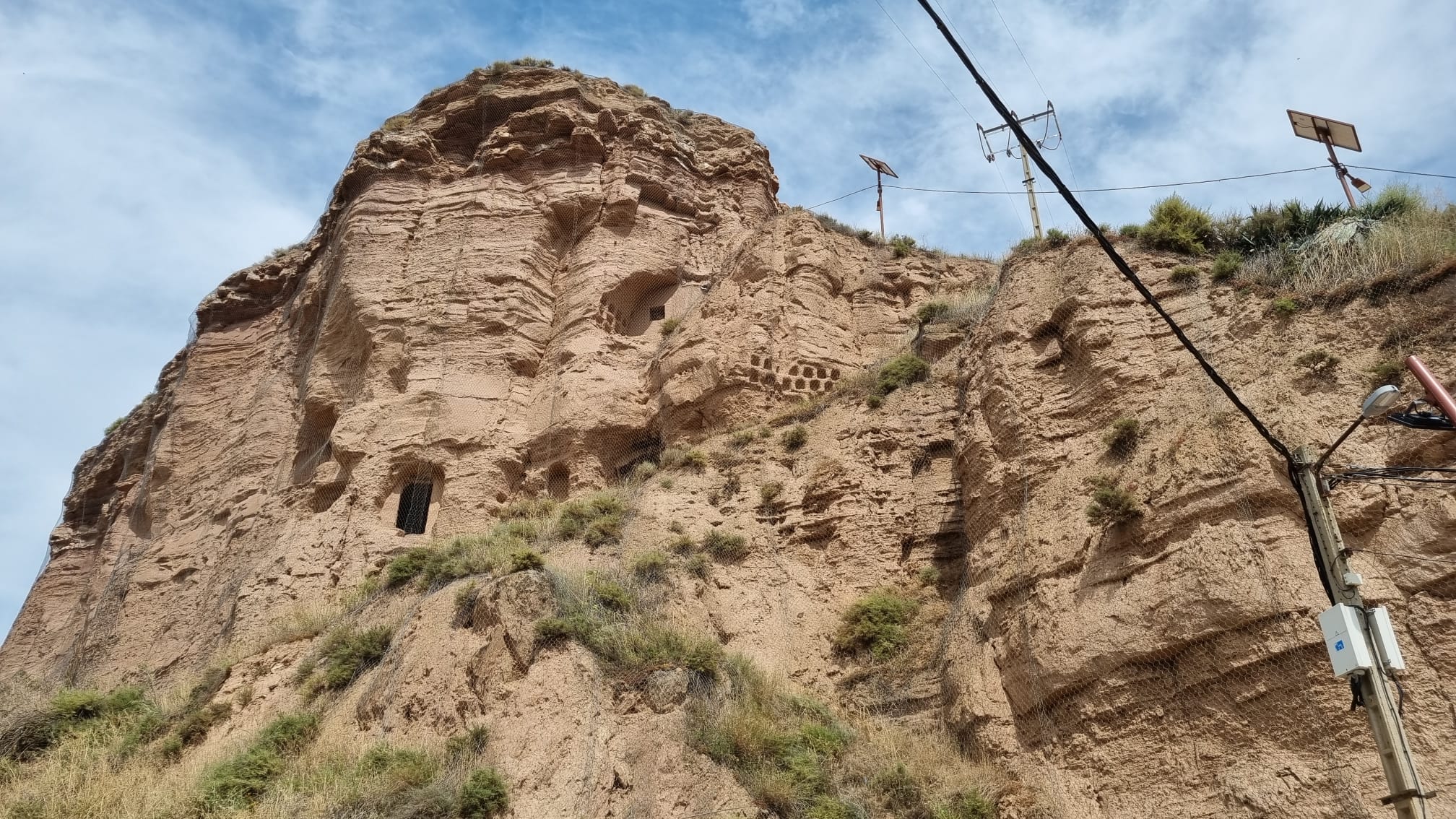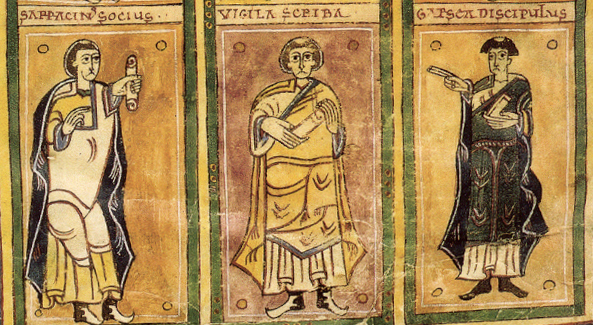|
San Martín De Albelda
San Martín de Albelda was a Riojan monastery, whose ruins now lie within the municipal boundaries of Albelda de Iregua. It was an important and advanced cultural centre in Spain and western Europe during the tenth century. The monastery was founded on 5 January 924 by Sancho Garcés I and Toda Aznárez, monarchs of Navarre, in gratitude for the recent reconquest of Nájera and Viguera (923) in conjunction with Ordoño II of León. The community was founded secundum Benedicti regulam uel id quod a sanctis patribus didicisti'', that is, according to the Benedictine rule. It took its name—''monasterium Albaidense'' or ''Albaildense''—from the Muslim fortress of al-Bayadh (the White), on the site of which it was founded. Its first abbot was named Peter, but on 5 January 925, in a royal privilege granted on the anniversary of its founding, the abbot was Gabellus, suggesting that the monastery had perhaps been attacked during the invasion of Abd ar-Rahman III the previous year ... [...More Info...] [...Related Items...] OR: [Wikipedia] [Google] [Baidu] |
Ruinas Del Monasterio De San Martín De Albelda
Ruinas ( sc, Arruìnas) is a ''comune'' (municipality) in the Province of Oristano in the Italy, Italian region Sardinia, located about north of Cagliari and about east of Oristano. Ruinas borders the following municipalities: Allai (OR), Allai, Asuni, Mogorella, Samugheo, Siamanna, Villa Sant'Antonio, Villaurbana. References Cities and towns in Sardinia {{Sardinia-geo-stub ... [...More Info...] [...Related Items...] OR: [Wikipedia] [Google] [Baidu] |
Diocese
In Ecclesiastical polity, church governance, a diocese or bishopric is the ecclesiastical district under the jurisdiction of a bishop. History In the later organization of the Roman Empire, the increasingly subdivided Roman province, provinces were administratively associated in a larger unit, the Roman diocese, diocese (Latin ''dioecesis'', from the Greek language, Greek term διοίκησις, meaning "administration"). Christianity was given legal status in 313 with the Edict of Milan. Churches began to organize themselves into Roman diocese, dioceses based on the Roman diocese, civil dioceses, not on the larger regional imperial districts. These dioceses were often smaller than the Roman province, provinces. Christianity was declared the Empire's State church of the Roman Empire, official religion by Theodosius I in 380. Constantine the Great, Constantine I in 318 gave litigants the right to have court cases transferred from the civil courts to the bishops. This situ ... [...More Info...] [...Related Items...] OR: [Wikipedia] [Google] [Baidu] |
Clavijo
Clavijo is a municipality of the autonomous community of La Rioja (Spain). It is located near the capital, Logroño. , its population was of 276 inhabitants. In 834, according to a 12th-century spurious charter and later traditional records, the legendary battle of Clavijo between Ramiro I of Asturias and Abd ar-Rahman II of Córdoba took place nearby, but the battle was a fabrication and didn't take place. Main sights *Castle, built by the Moors The term Moor, derived from the ancient Mauri, is an exonym first used by Christian Europeans to designate the Muslim inhabitants of the Maghreb, the Iberian Peninsula, Sicily and Malta during the Middle Ages. Moors are not a distinct or ... in the 9th century *Monastery of ''San Prudencio de Monte Laturce'', founded in the 6th century *Hermitage of Santiago (18th century) *Parish church (16th-17th century) File:Vista del pueblo de Clavijo y su Castillo.JPG, Far view of the Castle of Clavijo File:Interior del Castillo de ... [...More Info...] [...Related Items...] OR: [Wikipedia] [Google] [Baidu] |
Sancho Garcés III Of Navarre
Sancho Garcés III ( 992-996 – 18 October 1035), also known as Sancho the Great ( es, Sancho el Mayor, eu, Antso Gartzez Nagusia), was the King of Pamplona from 1004 until his death in 1035. He also ruled the County of Aragon and by marriage the counties of Castile, Álava and Monzón. He later added the counties of Sobrarbe (1015), Ribagorza (1018) and Cea (1030), and would intervene in the Kingdom of León, taking its eponymous capital city in 1034. He was the eldest son of García Sánchez II and his wife Jimena Fernández. Biography Birth and succession The year of Sancho's birth is not known, but it is no earlier than 992 and no later than 996. His parents were García Sánchez II the Tremulous and Jimena Fernández, daughter of Fernando Bermúdez, count of Cea on the Leonese frontier. García and Jimena are first recorded as married in 992, but there is no record of their son Sancho until 996. The first record of the future king is a diploma of his father's g ... [...More Info...] [...Related Items...] OR: [Wikipedia] [Google] [Baidu] |
Arabic Numerals
Arabic numerals are the ten numerical digits: , , , , , , , , and . They are the most commonly used symbols to write Decimal, decimal numbers. They are also used for writing numbers in other systems such as octal, and for writing identifiers such as computer symbols, trademarks, or license plates. The term often implies a decimal number, in particular when contrasted with Roman numerals. They are also called Western Arabic numerals, Ghubār numerals, Hindu-Arabic numerals, Western digits, Latin digits, or European digits. The ''Oxford English Dictionary'' differentiates them with the fully capitalized ''Arabic Numerals'' to refer to the Eastern Arabic numerals, Eastern digits. The term numbers or numerals or digits often implies only these symbols, however this can only be inferred from context. It was in the Algerian city of Béjaïa that the Italian people, Italian scholar Fibonacci first encountered the numerals; his work was crucial in making them known throughout Europe. ... [...More Info...] [...Related Items...] OR: [Wikipedia] [Google] [Baidu] |
Urraca Fernández
Urraca Fernández (died 1007) was queen of León and Navarre as the wife of two kings of León and one king of Navarre between 951 and 994. She acted as regent for her son Gonzalo in the County of Aragon in circa 996-997, and served as co-regent of the Kingdom of Navarre, along with her daughter-in-law Jimena Fernández and the bishops of Navarre, during the minor regency of her grandson Sancho III in circa 1004-1010. Life She was ''infanta'' of Castile and daughter of Count Fernán González and queen Sancha Sánchez of Pamplona. She was first married by her father to Ordoño III of León in 951. By him she had one child: *Bermudo II of León, whose maternity is subject to scholarly debateAlfonso Ceballos-Escalera (p. 159 de su obra Reyes de León: Ordoño III (951–956), Sancho I (956–966), Ordoño IV (958–959), Ramiro III (966–985), Vermudo II (982–999), editorial La Olmeda, Burgos, 2000 ) In 958, after Ordoño's death, she was remarried to Ordoño IV. He died ... [...More Info...] [...Related Items...] OR: [Wikipedia] [Google] [Baidu] |
Ramiro Garcés Of Viguera
Ramiro Garcés (Basque: ''Ramiro Gartzia''; died 9 July 981) was the first King of Viguera, since the establishment of the kingdom in 970 until his death in 981. He was the eldest son of García Sánchez I of Pamplona with his second wife, Teresa of León. It is suggested that while Teresa pushed for the disinheritance of García's eldest son Sancho II of Pamplona in favour of Ramiro, García compromised and willed the region of Viguera to Ramiro with the title of king. Ramiro was a ''subregulus'' and vassal of his brother. In 975 he tried to raid neighbouring Muslim territory, but was defeated in the Battle of Estercuel on 6 July. The precise date of his death is not recorded. A surviving document dated 981 reports that he had already died. Arabic sources report that he died in the Battle of Torrevicente in 981, where he and García Fernández of Castile fought Almanzur in support of Cordoban rebel Galib. He had two known children, Sancho The name Sancho is an Iberian name ... [...More Info...] [...Related Items...] OR: [Wikipedia] [Google] [Baidu] |
Sancho Garcés II Of Pamplona
Sancho Garcés II (Basque: ''Antso II.a Gartzez'', c. 938 – 994), also known as Sancho II, was King of Pamplona and Count of Aragon from 970 until his death in 994. He was the eldest son of García Sánchez I of Pamplona and Andregoto Galíndez. He recognised the Kingdom of Viguera during his reign. Nickname He is sometimes referred to as Sancho ''Abarca'' by modern sources. This appellation was first applied to Sancho II by chroniclers writing centuries after his time who were confused about the succession to Pamplona, creating a single ruler out of the combined careers of Sancho II and his grandfather Sancho I of Pamplona. The weight of evidence suggests that this nickname originally applied to Sancho I. Biography Sancho Garcés was born circa 938, son of García Sánchez I of Pamplona, the second King of Pamplona from the Jiménez dynasty, and his first wife Andregoto Galíndez, daughter of Galindo Aznárez II, Count of Aragon. His maternal grandfather died without any ... [...More Info...] [...Related Items...] OR: [Wikipedia] [Google] [Baidu] |
Codex Albeldensis
The ''Codex Vigilanus'' or ''Codex Albeldensis'' (Spanish: ''Códice Vigilano'' or ''Albeldense'') is an illuminated compilation of various historical documents accounting for a period extending from antiquity to the 10th century in Hispania. Among the many texts brought together by the compilers are the canons of the Visigothic Councils of Toledo, the ''Liber Iudiciorum'', the decrees of some early popes and other patristic writings, historical narratives (such as the ''Crónica Albeldense'' and the '' Life of Mohammed''), various other pieces of civil and canon law, and a calendar. It is now in the library of El Escorial monastery, with the shelfmark D.I.2. The compilers were three monks of the Riojan monastery of San Martín de Albelda: Vigila, after whom it was named and who was the illustrator; Serracino, his friend; and García, his disciple. The first compilation was finished in 881, but was updated up to 976. The original manuscript is preserved in the library of El E ... [...More Info...] [...Related Items...] OR: [Wikipedia] [Google] [Baidu] |


